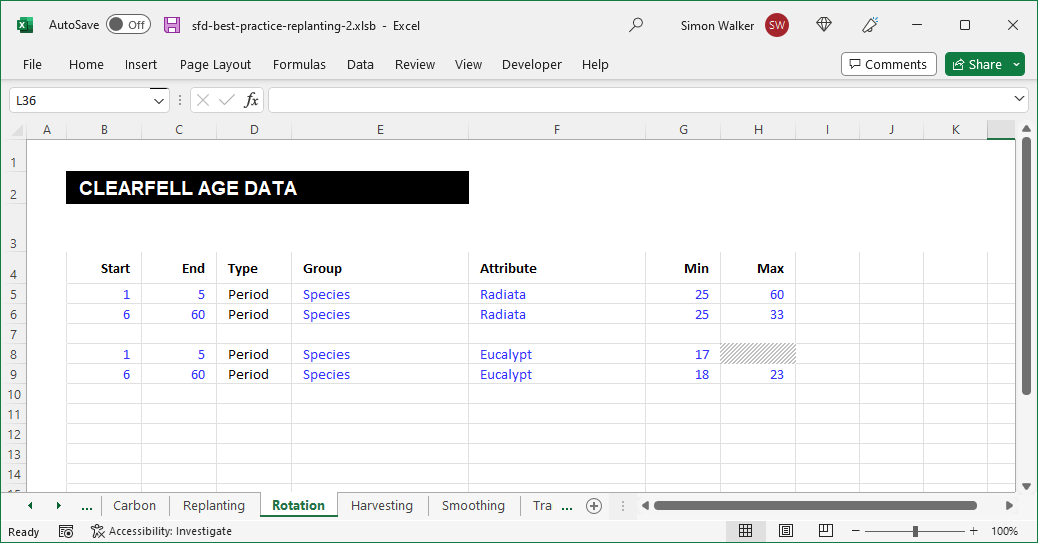Rotation Worksheet¶
Optional Worksheet
If there is no Rotation worksheet in the forest description workbook the system looks at the yield table assigned to each plunit and defaults to the first age of non-zero Total Recoverable Volume (TRV) as the plunit's minimum clearfell age, and the last age of non-zero TRV as the plunit's maximum clearfell age. If the plunit does not have a yield table with a non-zero TRV assigned via the Croptype group then the system defaults to a minimum clearfell age of 0 and a maximum clearfell age equal to the maximum number of age classes defined in the model.
The Rotation worksheet defines the minimum and maximum ages of clearfell. The resulting age range is by convention defined so that the minimum clearfell age is just old enough to prevent pre-merchantable timber from being harvested. For example, radiata pine in New Zealand will likely have a minimum clearfell age of at least 25 years so that the resulting log qualities would be acceptable to the market into which it is sold.
Ultimately the number of non-zero values in a sparse matrix defines the linear programming matrix creation and solve times. Focusing on keeping the non-zero count of the model as low as possible while not sacrificing model utility or accuracy is best practice. The clearfell age range defined on the Rotation worksheet has a very large influence on the number of non-zero values in the optimisation model.
Therefore, while the minimum clearfell age is strongly influenced by merchantability outcomes, the maximum clearfell age is influenced by both the existing age of the standing timber as well as the practicalities of best practice in minimising the number of non-zero values in the resulting linear programming model.
It is convention to have a wide clearfell age range in the near term of the model before moving to a more confined clearfell age range for the remainder of the model. This allows a maximum clearfell age to be set that exceeds the oldest age of any plunit across the first few modelling periods.
The maximum clearfell age should still be set high enough so that the model has the latitude to let plunits grow older than the average to allow modelling constraints such as non-declining yields, wood flow smoothing and other forest regulation requirements to be met. Typically planning units would be given a ~7 to 8 year clearfell range from the minimum merchantable age.
Example¶
The concepts outlined above are shown in the example below on the worksheet rows 5 and 6, where an age range of 25 to 60 years is available for radiata pine in periods 1 to 5 of the model before the age range is reduced to 25 to 33 years for periods 5 to 60. Across periods 1 to 5 the model can harvest plunits that exist at older ages before the clearfell range is reduced in order to minimise the number of non-zero values in the linear programming model.
Note
Note above that across Periods 1 to 5 the species Eucalypt does not have a maximum clearfell age defined. The shaded Cell 'H8' is blank. When a plunit does not have either a minimum or maximum clearfell age defined the system looks at the yield table assigned to each plunit and defaults to the first age of non-zero Total Recoverable Volume (TRV) if a minimum clearfell age is not entered or the last age of non-zero TRV if a maximum clearfell age is not entered.
Column Definitions¶
Users should not insert columns before Column 'B' and should not insert rows before Row '4'. The ordinal position of the data columns must remain.
| Group | Column | Description |
|---|---|---|
| Start | B | This is the starting period to which the constraint defined on the row applies. |
| End | C | This is the ending period to which the constraint defined on the row applies. |
| Type | D | This is either a value of 'Period' or 'Total'. A value of 'Period' defines the row constraint to apply 'in each and every period' of the range. A value of 'Total' defines the row constraint to apply 'as the sum total' across the period range. This value is set to 'Period' by convention on the Rotation worksheet as setting it to 'Total' results in the exact same outcome as 'Period'. |
| Group | E | This a Group from the Plunits worksheet that has been defined with attributes assigned to one or more plunits. |
| Attribute | F | This is a valid Attribute of the selected Group, and this Attribute selects the plunits to which the minimum and maximum clearfell ages will be applied. |
| Min | G | This is the minimum age of clearfell for the period range and plunits referenced by Group/Attribute data of the row. |
| Max | H | This is the maximum age of clearfell for the period range and plunits referenced by Group/Attribute data of the row. |
Note
Throughout the forest description, groups 'Start' and 'End' always infer and apply to a period, while groups 'Min' and 'Max' always infer and apply to an age.
